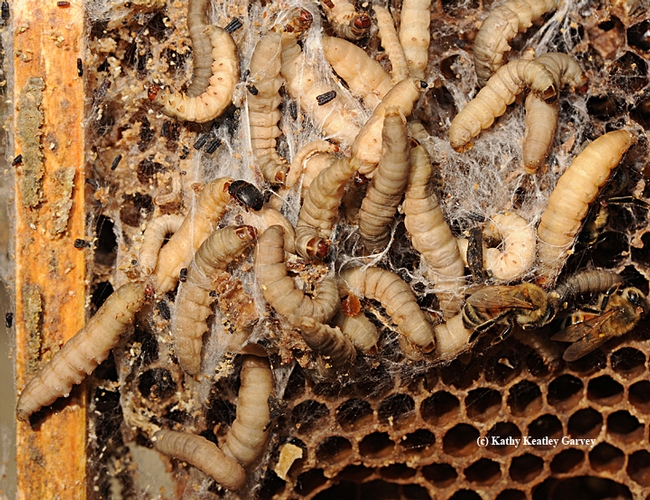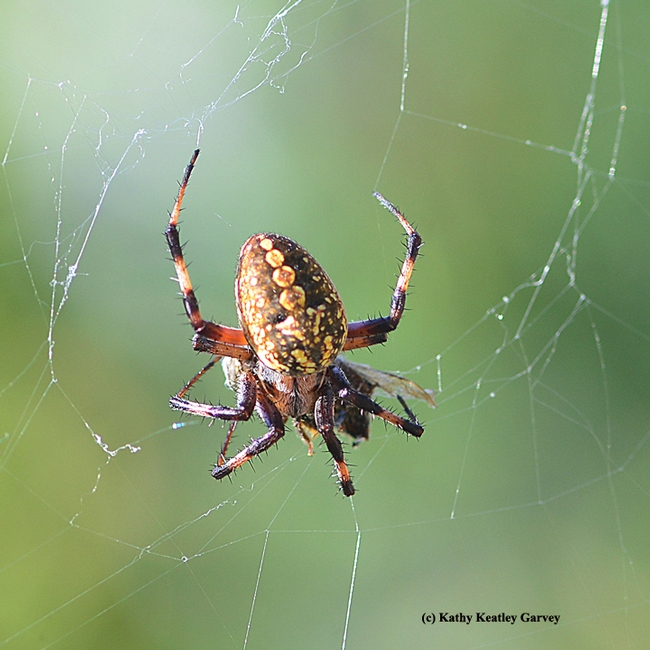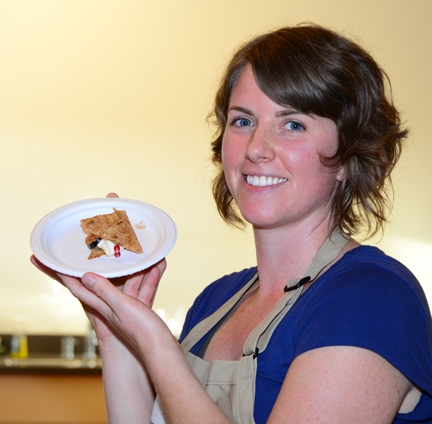
Posts Tagged: Robert Mondavi Institute for Wine and Food Science
You Can Make a Meal Out of Mealworms
You can make a meal out of mealworms. It's cricket to eat Cambodian crickets. And who wouldn't want a plate of teriyaki grasshopper kebobs paired with Rubicon Angus Scottish Ale? "Don't worry, be hoppy," said celebrity bug chef David George Gordon, author of the award-winning...

Flavored meal worms were first on the menu. (Photos by Kathy Keatley Garvey)

"Pope of Foam" Charlie Bamfroth talked about why he paired certain beers with bugs.

Javier Miramontes and Anne Schellman played with their food, a Cambodian cricket.
Have a Few Crickets With Your Kölsch
These things go together: Ham and eggs, macaroni and cheese, and beer and bugs. Beer and bugs? Definitely! Haven't you ever had a few crickets with your Kölsch? Well, you will if you attend the Robert Mondavi Institute for Wine and Food Science's event, "Bugs and Beer—Why Crickets and...

Would you eat honey bee larvae? (Photo by Kathy Keatley Garvey)

Wax moth larvae: good source of protein? And throw in a few small hive beetles for good measure? (Photo by Kathy Keatley Garvey)
The Good Life
Okra. You either love it or hate. If you hate it, it's probably because of its characteristic "slime" that it produces. It's a mucilaginous plant. If you love it-- absolutely love it--you may be from the Deep South, where okra is king. They bread the slender green pods and deep-fry them. And they...

A garden spider wraps its prey, a honey bee, in The Good Life Garden. (Photo by Kathy Keatley Garvey)

Garden spider struggles with its prey, a honey bee. (Photo by Kathy Keatley Garvey)
Mid-winter feast to celebrate bees and honey

And with the blossoms come the bees on which so many California crops depend for pollination.
In celebration of this vibrant time of year and the bees and beekeepers who help bring it to life, a special five-course gourmet dinner will be held Saturday, Feb. 8, at the Robert Mondavi Institute for Wine and Food Science at UC Davis.
The Mid-Winter Beekeeper’s Feast: A Taste of Mead and Honey is coordinated by the Mondavi Institute’s Honey and Pollination Center as a showcase for local, seasonal foods and a fundraiser for the center.
The dinner, which will be from 6:30 p.m. to 9:30 p.m. in the Sensory Building of the Robert Mondavi Institute, has been designed by UC Davis alumna Ann Evans using her “Davis Farmer’s Market Cookbook” and by Mani Niall, author of numerous cookbooks including “Covered in Honey” and his latest venture, “Sweet!”
Each of the five courses will feature seasonally available foods that are enhanced with varietal honeys, wines and mead. The meal will conclude with a cheese course with fresh honeycomb and a selection of mead. The mead tasting will be guided by Darrell Corti, an international wine judge.
The event will be accompanied by a musical trio and include a silent auction of gift baskets and unique food-, wine- and honey-focused opportunities.
Proceeds from the evening will benefit the Honey and Pollination Center, which coordinates educational and research efforts in support of all aspects of the beekeeping industry.
If you’re interested in joining in this celebration of the bounty of the beehive and beekeepers, visit the events section of the Robert Mondavi Institute website and look for the Mid-Winter Beekeeper’s Feast flyer and registration information, including details for purchasing either single tickets or sponsoring an entire table.
Pomegranates, figs and honey!

And honey? The Golden State ranks second in honey production, eclipsed only by North Dakota.
So why not combine all of them into a dessert? And add some walnuts and goat cheese for good measure--and good taste?
That’s exactly what Julie Loke of the Davis Food Co-Op did at the debut event of the newly established Honey and Pollination Center of the Robert Mondavi Institute for Wine and Food Science (RMI) at UC Davis.
The event, held Oct. 27 in the RMI’s Silverado Vineyards Sensory Theatre, drew talks on honey and pollination, and showcased a bee observation hive from the Harry H. Laidlaw Jr. Honey Bee Research Facility.
The Honey and Pollination Center, approved earlier this year by the UC Davis College of Agricultural and Environmental Sciences, aims to “make UC Davis the nation’s leading authority on honey, honey bees and pollination by combining the resources and expertise of RMI and the Department of Entomology’s Harry H. Laidlaw Jr. Honey Bee Research Facility,” said RMI executive director Clare Hasler-Lewis.
The center's goals include:
- Expand research and education concerning nutrition, health, quality and appreciation of honey
- Develop useful information for California’s agricultural bounty that depends on insect pollination
- Help the honey industry establish labeling guidelines to guarantee pure and unadulterated varietal honey
- Coordinate a multidisciplinary team of experts in honey production, pollination and bee health
- Promote the use of locally procured honey in the home, food industry and restaurants
Loke, the Davis Co-Op Teaching Kitchen coordinator, says she’s been obsessed with food for as long as she can remember. With 10 years of experience following “foodie adventures” (her repertoire includes running a kitchen on an eco-cruise, working in an organic garden, and teaching kids how to cook from scratch), she now teaches cooking classes at the Davis Co-Op, where she works full-time doing marketing, education and events.
The pomegranate is one of her favorite new foods.
“I’m from the East Coast and Midwest and had very little exposure to them growing up,” she said. “I love the act of breaking open the skin and having the arils (the juicy seeds) pop out, like a beautiful present! I love to eat them just out of hand but have incorporated them in everything from grains with toasted almonds to tossing them in most any salad and especially in desserts for a fun pop of tartness."
So when Loke delivered her presentation on how to make Baklava-Inspired Napoleans with fresh figs, pomegranate, honey and chevre mousse - and then served the dessert to the crowd - the crowd clamored for more.
This pastry serves 6 to 8 people, but “depending on how you cut the baklava and how much mousse you use, it could feed even more,” Loke says. She describes it as "crispy layers of phyllo dough, walnuts and spices, balanced atop dollops of tangy goat cheese mousse with fresh local figs, drizzled in California orange blossom honey."
Baklava Inspired Napoleans with Fresh Figs, Pomegranate, Honey and Chevre Mousse
Ingredients:
1/2 stick of butter
10 sheets whole wheat phyllo dough, thawed
10 fresh figs, sliced into thinnish rounds or thin wedges, tossed in a little thinned honey
2 cups chevre mousse (see recipe below)
1/4 cup honey, such as Moonshine Trading Company’s California orange blossom
1 cup finely chopped raw walnuts or pistachios
1/2 cup raw sugar
1 teaspoon cinnamon
1/4 teaspoon nutmeg
1/4 teaspoon allspice
Directions:
Thaw phyllo dough in the refrigerator overnight. Pre-heat oven to 400 degrees. You can melt the butter in the preheating oven or in short bursts in the microwave or in a pan on the stove—watch it closely. Set aside in a warm spot on the stove.
In a food processor, finely mince the nuts, sugar and all of the spices. It should be fairly fine easy to sprinkle over the dough. Or chop by hand and mix. Set aside. This will be layered between each sheet of phyllo dough. Prepare two sheet pans that are large enough to hold the phyllo sheets or close to it; you can always trim the phyllo to fit. Gently unwrap the phyllo and cover with a clean, damp fuzz-free dishtowel. Lift a whole sheet of phyllo from the pile and carefully lay out over the sheet pan. Replace the damp dishtowel over the pile. Using a pastry brush, lightly butter the first layer and lightly sprinkle with the spiced nut filling. Repeat and continue until you’ve done 4 sheets. Now carefully cut into 4-inch x 4-inch squares, or any other size or shape you can imagine. Then repeat the whole process on the other pan. Place into a 400 degree oven for about 10 minutes, or until golden brown and flaky. Let cool and then using your figs, honey and chevre mousse, layer into little towers. Drizzle all over with honey.
Chevre Mousse
1/2 cup heavy cream
1/4 cup goat cheese (chevre), room temperature
1 teaspoon pure vanilla extract and/or orange zest
2 tablespoons sugar
In a mixing bowl, whip the goat cheese with the whisk attachment until it starts to soften. Add the cream and orange zest and continue mixing until soft peaks just begin to form. Be careful you don’t overheat.
(Editor's note: If a pomegranate perplexes you, Julie Loke will be teaching a short introductory class on pomegranates at 6 p.m. Wednesday, Jan. 9, in the teaching kitchen of the Davis Food Co-op. She’ll show folks how to select, cut open, and juice pomegranates, and she'll provide a few recipes as well. The cost is $7. See http://davisfood.coop/education/cookingclasses.)

California is the sole producer of 99 percent of the pomegranates grown in the United States. (Photo by Kathy Keatley Garvey)

This bee observation hive from the Harry H. Laidlaw Jr. Honey Bee Research Facility was showcased at the Honey and Pollination Center event. (Photo by Kathy Keatley Garvey)

Close-up of Baklava-Inspired Napoleans. (Photo by Kathy Keatley Garvey)
